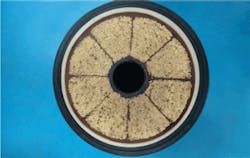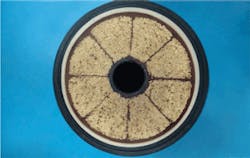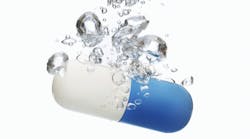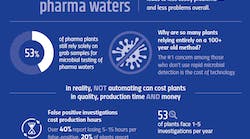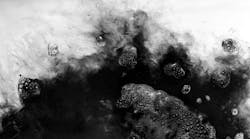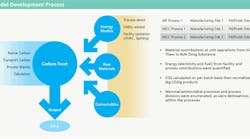[pullquote]Wastewater treatment is an important part of pharmaceutical manufacturing for several reasons. First, the pharmaceutical industry requires a large volume of water for various processes, and chemicals and other substances used in the manufacturing process often result in copious amounts of wastewater with high levels of contaminants and/or organic content that require specialized treatment (whether for reuse or ultimately, discharge).
Second, companies are increasingly integrating recycled water into their industrial processes. This practice can yield significant benefits from an environmental standpoint, through the conservation of raw water resources or by helping to reduce energy consumption. However, wastewater destined for recycling must also be treated appropriately before it can be reused, and in the case of pharmaceutical manufacturing plants, more intensive treatment is required.
Ultrafiltration (UF) — a membrane treatment process — is an important part of the wastewater treatment system, often used in the pretreatment (prefiltration) stage in reverse osmosis (RO) systems. UF separates solutes in the 20 to 1000 angstrom (up to 0.09 micron) size range and helps protect the RO membranes by reducing the silt density index (SDI) of the water and removing particulates that can cause fouling.
ADVANCEMENTS IN ULTRAFILTRATION MEMBRANES
Ultrafiltration membranes have undergone many advancements over the years since their first development. The fine filtration through the pore size range of around 0.02 to 0.09 microns has evolved as a major pre-filtration system, upstream of RO plants. The use of UF membranes has enhanced the performance of RO systems and the membranes are being widely used in various applications like surface water treatment, desalination systems, treating municipal wastewater and industrial effluent.
The case study that follows discusses how technological advances in UF manufacturing have helped to improve UF performance and reliability for very challenging industrial effluents such as wastewater streams in pharmaceutical manufacturing.
Manufacturing UF fibers that make up membrane modules is a very sophisticated process. Producing millions of pores with a uniform pore size distribution, which will actually govern the filtrate quality and flow per square meter of membrane, has always been a very challenging task. The performance of a UF system depends upon factors such as the system design, choice of dead end or cross flow (perpendicular direct flow or tangential flow with recirculation), optimum flux design (a direct indicator of the productivity of the membrane process) and effectiveness of backwash (removal of foulants on the surface of the membrane by filtrate water). These factors are mostly external and have been decided by system integrators, largely based on their experience and recommendations of membrane manufacturers.
The inherent manufacturing limitations of the fiber manufacturing process also have been one of the important factors in the above challenges. Each fiber has millions of pores of small size (for example, 0.02 microns). These pores are formed during the fiber spinning process. There is bound to be the variation in the size of pores as this is not a mechanical process where millions of holes are drilled. The extent of variation (pore size distribution) outside the acceptable limit (if the nominal pore size is 0.02 microns, the generally acceptable band is 0.017 to 0.024 microns) decides the flux and the filtrate quality of the membranes.
One notable advancement is a patented manufacturing technology called Cloud Point Precipitation (CPP). Cloud Point Precipitation — an enhancement of the Solvent Induced Phase Separation (SIPS) manufacturing process — ensures instantaneous formation of the membrane as the formulation makes contact with water. This process limits the variation in the pore size only to 2-5 percent outside the acceptable limits, ensuring that pore size distribution is more uniform. The uniformity in the pore size distribution allows the use of higher flux rates, better water quality and far better predictability in performance, as compared to conventional UF membranes. This is because the variation in the pore size is known and hence offers flexibility in optimizing the flux rates and predicting the performance of the membranes.
IMPROVING UF PERFORMANCE FOR PHARMACEUTICAL EFFLUENT RECYCLE
Q-SEP UF membranes are made from a hydrophilic polyether sulfone material that provides high fiber strength and low fouling characteristics.
A renowned pharmaceutical company based in India was founded with the aim of manufacturing life-saving immuno-biologicals. It is estimated that two out of every three children immunized in the world is vaccinated by a product manufactured by this organization. Their range of products has been supplied to international health agencies like the World Health Organization (WHO), UNICEF and Pan American Health Organization (PAHO), and their vaccines are being used in more than 140 countries across the globe. The company’s manufacturing facilities conform to the WHO cGMP requirements.The pharmaceutical company installed a water treatment system to recycle pharmaceutical process wastewater for reuse. Since various products are manufactured in the same facility, the effluent has always had variable constituents, posing challenges in water treatment. The water treatment system had employed UF membranes from a reputed manufacturer as pretreatment to a reverse osmosis (RO) system. The UF system was preceded by a tertiary system that was designed to remove a bulk of the suspended and organic particulates from the water. However, the existing UF membranes experienced repeated choking, and required frequent backwashing and chemical cleaning — up to three times in a day. RO performance was impacted due to frequent cleaning because of higher SDI values. These issues caused an increase in chemical usage throughout the system, O&M costs, and downtime of the system, all reducing the productivity of the system and impacting the company’s wastewater management program. After 7-8 months of operation, the membranes were completely fouled and needed replacement, so the company sought a more reliable and advanced UF solution.
Before replacing the existing membranes in their system, the company desired to conduct pilot trials on actual site conditions. QUA understood the criticality of the situation and offered its Q-SEP® ultrafiltration modules, manufactured with the Cloud Point Precipitation process, to the company to replace their existing UF membranes.
The piloting trials were successful and delivered the required product water quality with no irreversible fouling in the membranes, an essential requirement for reliable and sustainable operation of the RO and overall system.
With the success of the pilot trials, the company replaced their existing UF membranes with Q-SEP 6008 membranes. Q-SEP’s uniform pore size distribution (due to the CPP process) was a differentiating factor as the membrane proved to be extremely effective even in challenging effluents due to its composition.
Q-SEP UF membranes are made from a hydrophilic polyether sulfone (PES) material that provides high fiber strength and excellent low fouling characteristics, resulting in higher productivity. These hollow fiber membranes operate under low transmembrane pressure in an inside-out flow configuration for superior performance.
QUA conducted a detailed system audit and confirmed the suitability of the existing feed, backwash pumps, chemical dosing and automated valves. Q-SEP membrane modules were installed through a water treatment system integrator who did the modifications in the existing feed, product and reject pipe headers to accommodate the new membranes in the system.
The company’s UF plant with Q-SEP UF membranes has now been operating successfully for more than three years. In this time, the ultrafiltration membranes have reduced the chemically enhanced backwash frequency to a third of what was previously required. Additionally, reverse osmosis cleaning frequency has been reduced to half, and this is due to the higher quality water that the UF membranes are generating, with a low turbidity and silt density index. These key improvements have allowed the pharma company to save chemical costs, prevent costly downtime and frequent membrane replacements, and reduce maintenance requirements.
Q-SEP ultrafiltration also helped the company reduce its water footprint and helped reduce wastewater for their utility, lowering fresh water consumption, and reducing the quantity of effluent for final disposal. The ultrafiltration system has been a reliable and integral part of the overall pharmaceutical effluent recycle system to ensure an efficient overall production process.
